

Writer Guide
Chapter
8
Working with Graphics
This document is Copyright © 2011 by its contributors as listed below. You may distribute it and/or modify it under the terms of either the GNU General Public License (http://www.gnu.org/licenses/gpl.html), version 3 or later, or the Creative Commons Attribution License (http://creativecommons.org/licenses/by/3.0/), version 3.0 or later.
All trademarks within this guide belong to their legitimate owners.
Contributors
Ron
Faile Jr.
Barbara Duprey
Hal Parker
Feedback
Please direct any comments or suggestions about this document to: documentation@libreoffice.org
Acknowledgments
This chapter is based on Chapter 8 of the Writer Guide for OpenOffice.org. The contributors to that chapter are:
Agnes
Belzunce John Kane Vincenzo Ponzi
Gary Schnabl Barbara M.
Tobias Jean Hollis Weber
Michele Zarri
Publication date and software version
Published 14 February 2011. Based on LibreOffice 3.3.
Some keystrokes and menu items are different on a Mac from those used in Windows and Linux. The table below gives some common substitutions for the instructions in this chapter. For a more detailed list, see the application Help.
|
Windows/Linux |
Mac equivalent |
Effect |
|
Tools → Options menu selection |
LibreOffice → Preferences |
Access setup options |
|
Right-click |
Control+click |
Open context menu |
|
Ctrl (Control) |
z (Command) |
Used with other keys |
|
F5 |
Shift+z+F5 |
Open the Navigator |
|
F11 |
z+T |
Open Styles & Formatting window |
Contents
Preparing images for black-and-white printing 5
Inserting an image from the clipboard 8
Inserting an image using a scanner 9
Inserting an image from the Gallery 9
Flip vertically or horizontally 11
Using the formatting toolbar and Picture dialog box 12
Using Writer’s drawing tools 16
Set or change properties for drawing objects 17
Positioning graphics within the text 18
Wrapping text around graphics 20
Example 2: simple contour wrapping in action 24
Example 3: Wrap Through and In Background 25
Adding captions to graphics 25
Adding captions automatically 26
Using the Caption dialog box 26
Overriding the default positioning of captions 27
When you create a text document using LibreOffice (LibreOffice) Writer, you may want to include some illustrations. Illustrations (graphics) are added to documents for a wide variety of reasons: from supporting the description provided in the text—as used in this Guide—to providing an immediate visual representation of the contents, as is often found in a newspaper.
Graphics in Writer are of three basic types:
Image files, such as photos, drawings, and scanned images
Diagrams created using LibreOffice’s drawing tools
Charts created using LibreOffice’s Chart facility
This chapter covers images and diagrams.
More detailed descriptions on working with drawing tools can be found in the Draw Guide and Impress Guide. Instructions on how to create charts are given in the Calc Guide.
You might create images (also called ‘pictures’ in LibreOffice) using a graphics program, scan them, or download them from the Internet (make sure you have permission to use them), or use photos taken with a digital camera. Writer can import various vector (line drawing) and raster (bitmap) file formats. The most common are GIF, JPG, PNG, and BMP. See the Help for a full list.
Some things to consider when choosing or creating pictures include image quality and whether the picture will be printed in color or black and white (grayscale).
To edit photos and other bitmap images, use a bitmap editor. To edit line drawings, use a vector drawing program. You do not need to buy expensive programs. Open-source (and usually no cost) tools such as Gimp (bitmap editor) and Inkscape (vector drawing program) are excellent. For many graphics, LibreOffice Draw is sufficient. These and many other programs work on Windows, Macintosh OS X, and Linux.
For best results:
Create images that have the exact dimensions required for the document, or use an appropriate graphics package to scale photographs and large drawings to the required dimensions. Do not scale images with Writer, even though Writer has tools for doing this, because the results might not be as clear as you would like.
Do any other required image manipulation (brightness and contrast, color balance, cropping, conversion to grayscale, and so on) in a graphics package, not in Writer, even though Writer has the tools to do a lot of these things too.
If the document is meant for screen use only, there is no need to use high resolution images of 300 or more dpi (dots per inch). Most computer monitors work at between 72 and 96 dpi, reducing the resolution (and the file size) has no negative impact on what is displayed but does make Writer more responsive.
Preparing images for black-and-white printing
If color images are to be printed in grayscale, check that any adjacent colors have good contrast and print dark enough. Test by printing on a black-and-white printer using a grayscale setting. Better still: change the “mode” of the image to grayscale, either in a photo editor or in Writer itself (see “Graphics mode ” on page 11).
For example, the following diagram looks good in color. The circle is dark red and the square is dark blue. In grayscale, the difference between the two is not so clear. A third element in the diagram is a yellow arrow, which is almost invisible in grayscale.
|
Original drawing in color |
Drawing printed in grayscale |
Changing the colors of the circle and the arrow improves the contrast and visibility of the resulting grayscale image.
|
Original drawing in color |
Drawing printed in grayscale |
If the document will be available in black-and-white print only, a better result can often be obtained by choosing grayscale fills, not color fills—and you don’t have to guess and test to see if you’ve made good choices.
Images can be added to a document in several ways: by inserting an image file, directly from a graphics program or a scanner, or from the LibreOffice Gallery.
When the image is in a file stored on the computer, you can insert it into an LibreOffice document using either of the following methods.
Open a file browser window and locate the image you want to insert.
Drag the image into the Writer document and drop it where you want it to appear. A faint vertical line marks where the image will be dropped.
This method embeds (saves a copy of) the image file in the Writer document. To link the file instead of embedding it, hold down the Control+Shift keys while dragging the image.
Click in the LibreOffice document where you want the image to appear.
Choose Insert → Picture → From File from the menu bar.
On the Insert Picture dialog box, navigate to the file to be inserted, and select it.
At the bottom of the dialog box are two options, Preview and Link. Select Preview to view a thumbnail of the selected image on the right (as shown in the example), so you can verify that you have the correct file. See “Inserting an image file” below for the use of Link.
Click Open.
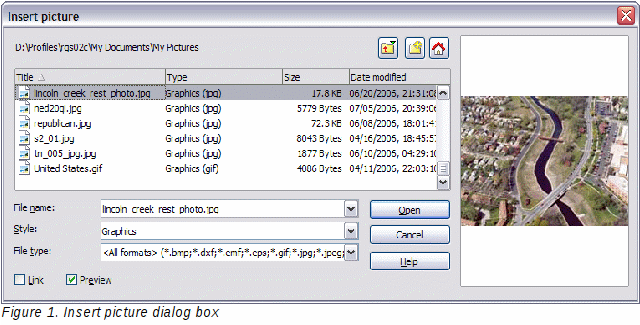
If the Link option in the Insert picture dialog box is selected, LibreOffice creates a link to the file containing the image instead of saving a copy of the image in the document. The result is that the image is displayed in the document, but when the document is saved, it contains only a reference to the image file—not the image itself. The document and the image remain as two separate files, and they are merged together only when you open the document again.
Linking an image has two advantages and one disadvantage:
Advantage – Linking can reduce the size of the document when it is saved, because the image file itself is not included. File size is usually not a problem on a modern computer with a reasonable amount of memory, unless the document includes many large graphics files; LibreOffice can handle quite large files.
Advantage – You can modify the image file separately without changing the document because the link to the file remains valid, and the modified image will appear when you next open the document. This can be a big advantage if you (or someone else, perhaps a graphic artist) is updating images.
Disadvantage – If you send the document to someone else, or move it to a different computer, you must also send the image files, or the receiver will not be able to see the linked images. You need to keep track of the location of the images and make sure the recipient knows where to put them on another machine, so the document can find them. For example, you might keep images in a subfolder named Images (under the folder containing the document); the recipient of the file needs to put the images in a subfolder with the same name (under the folder containing the document).
|
Note |
When inserting the same image several times in the document it would appear beneficial to create links; however, this is not necessary as LibreOffice embeds in the document only one copy of the image file. |
If you originally linked the images, you can easily embed one or more of them later if you wish. To do so:
Open the document in LibreOffice and choose Edit → Links.
The Edit Links dialog box shows all the linked files. In the Source file list, select the files you want to change from linked to embedded.
Click the Break Link button.
Save the document.
|
Note |
Going the other way, from embedded to linked, is not so easy—you must delete and reinsert each image, one at a time, selecting the Link option when you do so. |
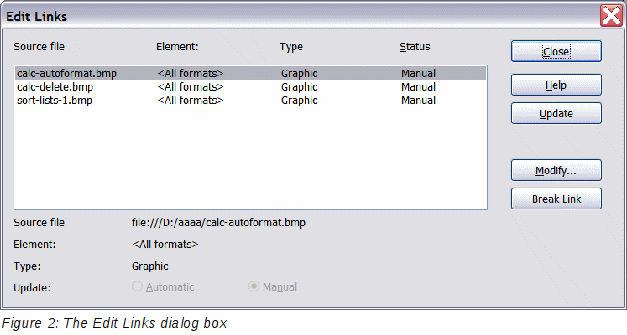
Inserting an image from the clipboard
Using the clipboard, you can copy images into an LibreOffice document from another LibreOffice document and from other programs. To do this:
Open both the source document and the target document.
In the source document, select the image to be copied.
Move the mouse pointer over the selected image and press Control+C to copy the image to the clipboard.
Switch to the target document.
Click to place the cursor where the graphic is to be inserted.
Press Control+V to insert the image.
|
Caution
|
If the application from which the graphic was copied is closed before the graphic is pasted into the target, the image stored on the clipboard could be lost. |
Inserting an image using a scanner
If a scanner is connected to your computer, LibreOffice can call the scanning application and inserted the scanned item into the LibreOffice document as an image. To start this procedure, click where you want the graphic to be inserted and select Insert → Picture → Scan → Select Source.
Although this practice is quick and easy, it is unlikely to result in a high-quality image of the correct size. You may get better results by scanned material into a graphics program and cleaning it up there before inserting the resulting image into LibreOffice.
Inserting an image from the Gallery
The Gallery provides a convenient way to group reusable objects such as graphics and sounds that you can insert into your documents. The Gallery is available in all components of LibreOffice. It does not come with many graphics, but you can add your own pictures or find extensions containing more graphics. The Gallery is explained in more detail in Chapter 11, Graphics, the Gallery, and Fontwork, in the Getting Started guide. For more about extensions, see Chapter 16, Customizing Writer, in this book.
This section explains the basics of inserting a Gallery image into a Writer document:
To
open the Gallery, click on the Gallery
icon
![]() (located in the right side of the Standard toolbar) or choose Tools
→
Gallery from the
menu bar.
(located in the right side of the Standard toolbar) or choose Tools
→
Gallery from the
menu bar.
Navigate through the Gallery to find the desired picture.
To insert the picture, click and drag it from the Gallery into the Writer document. You can also right-click on the picture and choose Insert → Copy.
Figure 3 shows an example of an image dragged from the Gallery.
By default, the Gallery is docked above the Writer workspace. To expand the Gallery, position the pointer over the line that divides it from the top of the workspace. When the pointer changes to parallel lines with arrows, click and drag downward. The workspace resizes in response.
To expand the Gallery without affecting the workspace, undock it so it floats over the workspace. To do so, hold down the Control key and double-click on the upper part of the Gallery next to the View icons. Double-click in the same area while holding down the Control key to dock it again (restore it to its position over the workspace).
When the Gallery is docked, to hide it and view the full Writer workspace, click the Hide/Show button in the middle of the thin bar separating the Gallery from the workspace (circled in Figure 3).
To close the Gallery, choose Tools → Gallery to uncheck the Gallery entry, or click on the Gallery icon again.
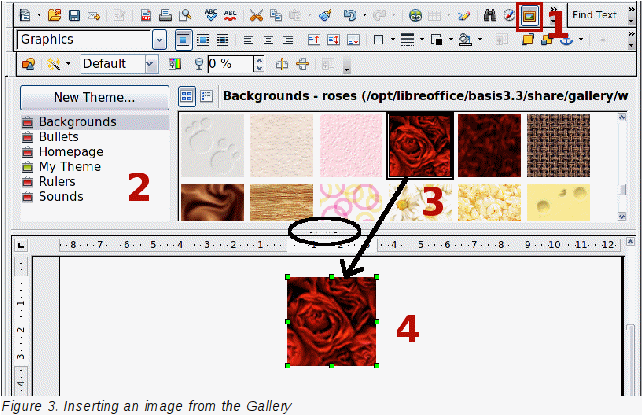
When you insert a new image, you may need to modify it to suit the document. The placement of the picture relative to the text is discussed in “Positioning graphics within the text” on page 18. This section describes the use of the Picture toolbar, resizing, cropping, and a workaround to rotate a picture.
Writer provides many tools for working with images. These tools are sufficient for most people’s everyday requirements. However, for professional results it is generally better to use an image manipulation program such as GIMP to modify images (for example, to crop, resize, rotate, and change color values) and then insert the result into Writer. GIMP is an open-source graphics program that can be downloaded from http://www.gimp.org/downloads/.
When you insert an image or select one already present in the document, the Picture toolbar appears. You can set it to always be present (View → Toolbars → Picture). Picture control buttons from the Picture toolbar can also be added to the Standard Toolbar. See Chapter 16, Customizing Writer, for more information.
This toolbar can be either floating or docked. Figure 4 shows what the Picture toolbar looks like when it is floating.
Two other toolbars can be opened from this one: the Graphic Filter toolbar, which can be torn off and placed elsewhere on the window, and the Color toolbar, which opens as a separate floating toolbar.
From these three toolbars, you can apply small corrections to the graphic or obtain special effects.
You can change color images to grayscale by selecting the image and then selecting Grayscale from the Graphics mode list.
Flip vertically or
horizontally
![]()
To flip an image vertically or horizontally, select the image, and then click the relevant icon.
Table 1 provides a short description of the available filters, however the best way to understand them is to see them in action. Feel free to experiment with the different filters and filters settings, remembering that you can undo all the changes by pressing Ctrl+Z or Alt+Backspace or by selecting Edit → Undo.
|
Note: Graphics mode (3) can be Default, Grayscale, Black/White, or Watermark. Figure 4. Picture toolbar plus tear-off Graphic Filter toolbar and floating Color toolbar |
1 |
From File |
|
2 |
Filter |
|
|
3 |
Graphics mode |
|
|
4 |
Color |
|
|
5 |
Transparency |
|
|
6 |
Flip Horizontally |
|
|
7 |
Flip Vertically |
|
|
8 |
Graphics Properties |
|
|
9 |
Invert |
|
|
10 |
Smooth |
|
|
11 |
Solarization |
|
|
12 |
Aging |
|
|
13 |
Charcoal Sketch |
|
|
14 |
Relief |
|
|
15 |
Mosaic |
|
|
16 |
Posterize |
|
|
17 |
Pop Art |
|
|
18 |
Sharpen |
|
|
19 |
Remove Noise |
|
|
20 |
Red |
|
|
21 |
Green |
|
|
22 |
Blue |
|
|
23 |
Brightness |
|
|
24 |
Contrast |
|
|
25 |
Gamma |
Table 1: Graphic filters and their effects
|
Icon |
Name |
Effect |
|
|
Invert |
Inverts the color values of a color image or the brightness values of a grayscale image. |
|
|
Smooth |
Softens the contrast of an image. |
|
|
Sharpen |
Increases the contrast of an image. |
|
|
Remove noise |
Removes single pixels from an image. |
|
|
Solarization |
Mimics the effects of too much light in a picture. A further dialog box opens to adjust the parameters. |
|
|
Aging |
Simulates the effects of time on a picture. Can be applied several times. A further dialog box opens to adjust the aging level. |
|
|
Posterize |
Makes a picture appear like a painting by reducing the number of colors used. |
|
|
Pop Art |
Modifies the picture dramatically. |
|
|
Charcoal |
Displays the image as a charcoal sketch. |
|
|
Relief |
A dialog box is displayed to adjust the light source that will create the shadow and, hence, the relief effect. |
|
|
Mosaic |
Joins groups of pixels into a single area of one color. |
Use this toolbar to modify the individual RGB color components of the image (red, green, blue) as well as the brightness, contrast, and gamma of the image. If the result is not satisfactory, you can press Control+Z to restore the default values.
Modify the percentage value in the Transparency box on the Picture toolbar to make the image more transparent. This is particularly useful when creating a watermark or when wrapping the image in the background.
Using the formatting toolbar and Picture dialog box
When an image is selected, you can customize some aspects of its appearance using the tools available on the Formatting toolbar (shown in Figure 9) as well as in the dialog box that is shown by right-clicking on the image and selecting Picture. You can, for example, create a border around the image, selecting style and color; or you can (in the Borders page of the Picture dialog box) add a shadow to the image.
When you are only interested in a section of the image for the purpose of your document, you may wish to crop (cut off) parts of it. The user interface offered in Writer for cropping an image is not very friendly, so it may be a better choice to use a graphics package.
|
Note |
If you crop an image in Writer, the picture itself is not changed. If you export the document to HTML, the original image is exported, not the cropped image. |
To start cropping the image, right-click on it and select Picture from the context menu. In the Picture dialog box, select the Crop page.
The units of measurement shown on the Crop page are those set in Tools → Options → LibreOffice Writer → General.
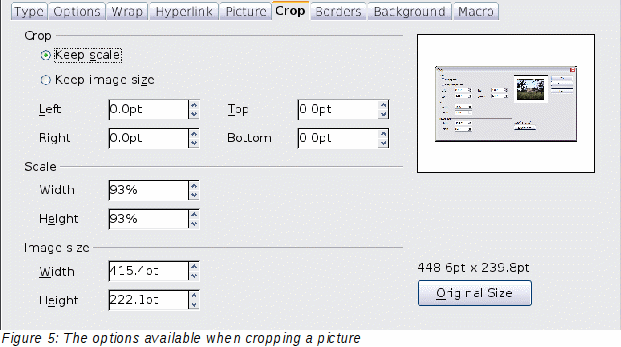
In the Crop page, you can control the following parameters:
Keep scale / Keep image size
When Keep scale is selected (default), cropping the image does not change the scale of the picture.
When Keep image size is selected, cropping produces enlargement (for positive cropping values), shrinking (for negative cropping values), or distortion of the image so that the image size remains constant.
Left, Right, Top, and Bottom
The image is cropped by the amount entered in these boxes. For example, a value of 3cm in the Left box cuts 3 cm from the left side of the picture.
When Keep scale is selected, the size of the image also changes, so in this example the width will be reduced by 3 cm.
When Keep image size is selected, the remaining part of the image is enlarged (when you enter positive values for cropping) or shrunk (when you enter negative values for cropping) so that the width and height of the image remains unchanged.
Width and Height
The Width and Height fields under either Scale or Image size change as you enter values in the Left, Right, Top, and Bottom fields. Use the thumbnail next to these fields to determine the correct amount by which to crop.
The inserted image might not fit perfectly into the document if it is too big or too small. In these cases you can use Writer to resize the image.
Click the picture, if necessary, to show the green resizing handles.
Position the pointer over one of the green resizing handles. The pointer changes shape giving a graphical representation of the direction of the resizing.
Click and drag to resize the picture.
Release the mouse button when satisfied with the new size.
The corner handles resize both the width and the height of the graphic object simultaneously, while the other four handles only resize one dimension at a time.
|
Tip |
To retain the original proportions of the graphic, Shift+click one of the corner handles, then drag. Be sure to release the mouse button before releasing the Shift key. |
Be aware that re-sizing a bit-mapped (raster) image will adversely affect the resolution, causing some degree of blurring. It is better to externally size your picture correctly before insertion into your presentation, if possible.
Figure 6 shows three examples of an image inserted into a document and resized.
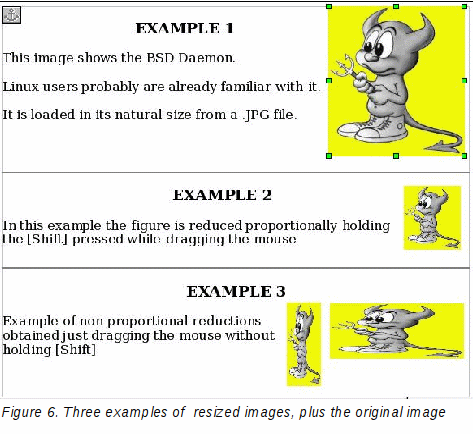
For more accurate resizing, use either the Crop page of the Picture dialog box (Figure 5) or, for images, the Type page of the Picture dialog box. On the Crop page you can either adjust the following settings or use the settings in the Crop section as described on page 13.
Scale Width and Height: specify in percentages the scaling of the picture. The size of the image changes accordingly. For a scaled resizing, both values should be identical.
Image size: specify the size of the image in your preferred unit of measurement. The image enlarges or shrinks accordingly.
Original size button: when clicked, restores the image to its original size.
In the Type page of the Picture dialog box, select the Relative option to toggle between percentage and actual dimension. For a scaled resizing, select the Keep ratio option. As for the Crop page, clicking on the Original Size button restores the original image size.
Writer does not provide a tool for rotating a picture; however, there is a simple workaround:
Open a new Draw or Impress document (File → New → Drawing or File → New → Presentation).
Insert the image you want to rotate. You can use any of the mechanisms described in “Adding images to a document” on page 6, although there are some slight variations in the position of the menu entries and icons.
Select the image, then in the
Drawing toolbar (shown by default at the bottom of the window in
Impress and Draw), select the Rotate
icon
![]() from the Effects
tear-off toolbar
from the Effects
tear-off toolbar
![]() .
.
Rotate the image as desired. Use the red handles at the corners of the picture and move the mouse in the direction you wish to rotate. By default the picture rotates around its center (indicated by a black crosshair), but you can change the pivot point by moving the black crosshair to the desired rotation center.
|
Tip |
To restrict the rotation angle to multiples of 15 degrees keep the Shift key pressed while rotating the image. |
Select the rotated picture by pressing Ctrl+A, then copy the image to the clipboard with Ctrl+C.
Finish by going back to the location of the Writer document where the image is to be inserted and pressing Ctrl+V.
The Picture dialog box (Figure 5) consists of eight pages. The Crop page was described on page 13, while the use of the Type and the Wrap pages is explained in “Positioning graphics within the text” on page 18. The other pages serve the following purposes:
Options: use this page to give the picture a descriptive name (as you want it to appear in the Navigator), display alternative text when the mouse hovers over the picture, and protect some of the picture settings from accidental changes. You can also prevent the picture from being printed by deselecting the corresponding option.
Borders: use this page to create borders around the picture. The Borders dialog box is the same as the one used for defining table or paragraph borders. You can also add a shadow to the image if so desired.
Background: use this page to change the background color of the picture. This setting produces the desired results only for images with a transparent color.
Hyperlink: use this page to associate a hyperlink to the picture. You can also create an image map so that only certain areas of the picture respond to a mouse click by opening the associated URI (Uniform Resource Identifier) in the default browser. More information on image maps can be found in the Impress Guide.
Picture: use this page to flip the picture as well as to display the original location of the file in case the image is linked rather than embedded.
Macro: allows you to associate a macro to the picture. You can choose among the predefined macros or write your own.
To delete a picture:
Click on the picture, to show the green resizing handles.
Press Delete.
You can use Writer’s drawing tools to create graphics, such as simple diagrams using rectangles, circles, lines, text, and other predefined shapes. You can also group several drawing objects to make sure they maintain their relative position and proportion.
You can place the drawing objects directly on a page in your document, or you can insert them into a frame.
You can also use the drawing tools to annotate photographs, screen captures, or other illustrations produced by other programs, but this is not recommended because:
You cannot include images in a group with drawing objects, so they may get out of alignment in your document.
If you convert a Writer document to another format, such as HTML, the drawing objects and the graphics will not remain associated; they are saved separately.
In general, if you need to create complex drawings, it is recommended to use LibreOffice Draw, which includes many more features such as layers, styles, and so on.
To begin using the drawing tools, display the Drawing toolbar (Figure 7), by clicking View → Toolbars → Drawing.
If you are planning to use the drawing tools repeatedly, you can tear off this toolbar and move it to a convenient place on the window.
|
|
|||||||
|
1 |
Select |
5 |
Freeform Line |
9 |
Symbol Shapes |
13 |
Stars |
|
2 |
Line |
6 |
Text |
10 |
Block arrows |
14 |
Points |
|
3 |
Rectangle |
7 |
Callouts |
11 |
Flowcharts |
15 |
Fontwork Gallery |
|
4 |
Ellipse |
8 |
Basic Shapes |
12 |
Callouts |
16 |
From File |
|
|
|
|
|
|
|
17 |
Extrusion On/Off |
|
Figure 7. The Drawing toolbar |
|||||||
To use a drawing tool:
Click in the document where you want the drawing to be anchored. You can change the anchor later, if necessary.
Select the tool from the
Drawing toolbar (Figure 7). The mouse pointer changes to a
drawing-functions pointer
![]() .
.
Move the cross-hair pointer to the place in the document where you want the graphic to appear and then click-and-drag to create the drawing object. Release the mouse button. The selected drawing function remains active, so you can draw another object of the same type.
To cancel the selected drawing function, press the Esc key or click on the Select icon (the arrow) on the Drawing toolbar.
You can now change the properties (fill color, line type and weight, anchoring, and others) of the drawing object using either the Drawing Object Properties toolbar (Figure 8) or the choices and dialog boxes reached by right-clicking on the drawing object.
Set or change properties for drawing objects
To set the properties for a drawing object before you draw it:
On the Drawing toolbar (Figure 7), click the Select tool.
On the Drawing Object Properties toolbar (Figure 8), click on the icon for each property and select the value you want for that property.
For more control, or to define new attributes, you can click on the Area or Line icons on the toolbar to display detailed dialog boxes.
The default you set applies to the current document and session. It is not retained when you close the document or close Writer, and it does not apply to any other document you open. The defaults apply to all the drawing objects except text objects.
|
|
|||||||
|
1 |
Line |
5 |
Line Color |
9 |
To Foreground |
13 |
Alignment |
|
2 |
Arrow Style |
6 |
Area |
10 |
To Background |
14 |
Change Anchor |
|
3 |
Line Style |
7 |
Area Style / Filling |
11 |
Bring to Front |
15 |
Ungroup |
|
4 |
Line Width |
8 |
Rotate |
12 |
Send to Back |
16 |
Group |
|
Figure 8. Drawing Object Properties toolbar |
|||||||
To change the properties for an existing drawing object:
Select the object.
Continue as described above.
You can also specify the position and size, rotation, and slant and corner radius properties of the drawing object:
Right-click on the drawing object and then click Position and Size from the context menu. The Position and Size dialog box is displayed.
Choose any properties, as required.
The same considerations for resizing an image apply also to resizing an object. Select the object, click on one of the eight handles around it and drag it to its new position. For a scaled resizing, select one of the corner handles and keep the Shift key pressed while dragging the handle to its new position.
For more sophisticated control of the size of the object, select Format → Object → Position and Size from the menu bar. Use the Position and Size dialog box to set the width and height independently. If the Keep ratio option is selected, then the two dimensions change so that the proportion is maintained, allowing for a scaled resizing.
To group drawing objects:
Select one object, then hold down the Shift key and select the others you want to include in the group. The bounding box expands to include all the selected objects.
With the objects selected, hover the mouse pointer over one of the objects and choose Format → Group → Group from the menu bar or right-click and choose Group → Group from the context menu.
|
Note |
You cannot include an embedded or linked graphic in a group with drawing objects. |
Positioning graphics within the text
When you add a graphic to a text document, you need to choose how to position it with respect to the text and other graphics. The positioning of graphics is often rather time-consuming and may be very frustrating for both inexperienced and experienced users. As Writer is a word processor rather than a desktop publishing program, there are some limitations to the flexibility in positioning images and it takes time to get things exactly as you would like them.
Positioning of a graphic is controlled by four settings:
Arrangement refers to the placement of a graphic on an imaginary vertical axis. Arrangement controls how graphics are stacked upon each other or relative to the text.
Alignment refers to the vertical or horizontal placement of a graphic in relation to the chosen anchor point.
Anchoring refers to the reference point for the graphics. This point could be the page, or frame where the object is, a paragraph, or even a character. An image always has an anchor point.
Text wrapping refers to the relation of graphics to the surrounding text, which may wrap around the graphic on one or both sides, be overprinted behind or in front of the graphic, or treat the graphic as a separate paragraph or character.
The settings can be accessed in a number of ways, depending on the nature of the graphics:
From the Format menu, where you can find Alignment, Arrange, Wrap, and Anchor (both for images and drawing objects).
From the context menu displayed when you right-click on the graphic.
From the OLE Object toolbar shown in Figure 9.
For images, from the Type and Wrapping pages of the Picture dialog box. Note that you cannot control the arrangement using the dialog box. To open the Picture dialog box, click on the image to select it and then choose Format → Picture or right-click on the graphic and choose Picture on the context menu.
For drawing objects, from the Position and Size page of the Position and Size dialog box. To open the Position and Size dialog box, click on the drawing object to select it and then choose Format → Object → Position and Size or right-click on the graphic and choose Position and Size on the context menu. Note that you can only control the alignment and anchoring.

Arranging a graphic object means to determine its vertical position relative to other graphic objects or text. Arranging is only relevant when objects are overlapping. You can choose between four settings, plus a special setting for drawing objects:
Bring to Front
Places the graphic on top of any other graphics or text.
Bring Forward
Brings the graphic one level up in the stack (z axis). Depending on the number of overlapping objects, you may need to apply this option several times to obtain the desired result.
Send Backward
The opposite of Bring Forward; sends the selected graphic one level down in the object stack.
Send to Back
Sends the selected graphic to the bottom of the stack, so that other graphics and text cover it.
To Background / To Foreground
Only available for drawing objects; moves the drawing object behind or in front of the text respectively.
You can anchor graphics as a character or to a page, paragraph, or character. You can also place graphics in a frame and anchor the frame to a page, paragraph, or character. Which method you choose depends on what you are trying to achieve.
Here are the ways you can anchor graphics or drawing objects:
To Page
The graphic keeps the same position in relation to the page margins. It does not move as you add or delete text or other graphics. This method is useful when the graphic does not need to be visually associated with a particular piece of text. It is often used when producing newsletters or other documents that are very layout intensive, or for placing logos in letterheads.
|
Caution
|
If you plan to use a document within a master document, do not anchor graphics To Page because the graphics will disappear from the master document. See Chapter 13, Working with Master Documents, for more information. |
To Paragraph
The graphic is associated with a paragraph and moves with the paragraph. It may be placed in the margin or another location. This method is useful as an alternative to a table for placing icons beside paragraphs.
To Character
The graphic is associated with a character but is not in the text sequence. It moves with the paragraph but may be placed in the margin or another location. This method is similar to anchoring to a paragraph but cannot be used with drawing objects.
As Character
The graphic is placed in the document like any other character and, therefore, affects the height of the text line and the line break. The graphic moves with the paragraph as you add or delete text before the paragraph. This method is useful for keeping screenshots in sequence in a procedure (by anchoring them as a character in a blank paragraph) or for adding a small (inline) icon in sequence in a sentence.
To Frame
If the graphic has been placed in a frame, you can anchor the graphic in a fixed position inside the frame. The frame can then be anchored to the page, a paragraph, or a character, as required.
Once you have established the anchor point of the graphic, you can decide the position of the graphic relative to this anchor: this is called aligning the graphics. Choose from six options: three for aligning the graphic horizontally (left, center, right) and three for aligning the graphic vertically (top, center, bottom). Horizontal alignment is not available for images anchored as character.
For finer control of the alignment, use the Position options on the Type page of the Picture dialog box, shown in Figure 10.

For both the horizontal and vertical position, start by picking the reference point in the right hand side drop-down menu, then select in the first drop-down menu among Left, Right or Center. If you select the value From left (or From top for the vertical positioning) you can specify the amount in your selected unit of measurement. In the example in Figure 10, the upper-left corner of the image will be placed at 3 cm from the left margin of the page horizontally and on the top margin vertically.
The Wrap setting determines the relation between the text and the graphic. Several possibilities are provided:
No Wrap
With this option the text is placed above and below the image but not around it. This is the wrapping type used for most of the figures in this guide.
Page Wrap or Optimal Page Wrap
The text flows around the image. Moving the image around the page causes the text to be rearranged to fill the space to the left and right of it. Optimal Page Wrap prevents text from being placed to the side of the image if the spacing between the image and the margin is less than 2 cm.
Wrap Through
Superimposes the image on the text. That is, the image is above the text. This option must be used in conjunction with the image-transparency setting in order to make the text under the picture visible.
In Background
Similar to Wrap Through, but the image is placed below the text so there may be no need to change the transparency to make the text visible.
|
Note |
The No Wrap option found in the context menu of a picture is equivalent to the Wrap Off menu item in the Format → Wrap menu. |
The wrap format is normally selected after the anchoring and the alignment of the picture have been decided. To set the position of an image to the desired wrap format, follow these steps:
Select a graphic by clicking on it.
Right-click to display the context menu and move the mouse pointer to Wrap to display the available wrap formats. Alternatively you can select Format → Wrap from the menu bar.
Select the desired wrap format.
|
Note |
When anchoring a graphic as character, you can only adjust the distance between the image and the text, but no wrapping option is displayed. |
To fine tune the wrapping options, open the Picture dialog box and select the Wrap page shown in Figure 11. For images you can open this dialog box by selecting Format → Picture from the menu bar or right-click and select Picture from the context menu. For drawing objects, you can access the Wrap page by selecting Format → Wrap → Edit in the menu bar or right-click and select Wrap → Edit from the context menu.
This page is divided into three sections. In the top part you can select among the wrap types mentioned above, plus two additional wrap formats that prevent the text from filling the area to the left (After) or to the right (Before) of the picture. Use the Spacing section of the page to adjust the spacing between the image and the text. The contents of the Options section of the page may change depending on the selected wrap format.
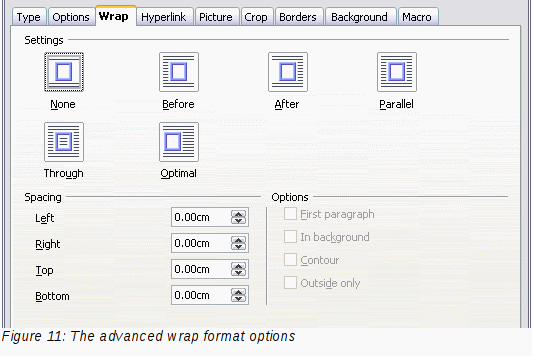
First paragraph
Check this box if you want LibreOffice to start a new paragraph after the image even if it could still wrap around the image.
In background
This option becomes available if Through Wrap is selected; it moves the image in the background.
Contour
Wraps the text around a custom contour rather than around the edge of the picture. This option is only available for Page or Optimal Page Wrap.
Outside only
Forces the text to wrap on the outside of the image, even if the contour contains open areas within the shape.
This option is only available for image wrapping. If you select wrapping around a drawing object, LibreOffice automatically creates a contour. You can access the Contour Editor by selecting Format → Wrap → Edit Contour or from the right-click menu
The dialog box of Figure 12 opens with the image loaded in the main window. Use the tools to draw the region of the image you do not want to be covered by the text—such area will be shaded.
Some familiarity with drawing tools is required to create complex contours; however, in most circumstances there is no need for high accuracy. Figure 12 shows the actual contour used for “Example 2: simple contour wrapping in action” and as you can see the shape of the line around the edge of the sphere is far from perfect.
When you are done, click on the Apply button to save the contour. If you are not satisfied with the result, you can select the contour line and press the Delete key to restart. You can also undo the previous steps or you can select the Edit Points button and adjust the contour shape point by point.
For simple images, the AutoContour button does a decent job. If the contour has to be drawn around an area with the same or a similar color, you can select this region using the eyedropper. Select this tool, then click on a point in the image having the desired color. LibreOffice automatically selects all the points which have the same or a similar color. The similarity level can be changed by modifying the value in the tolerance box (100% = perfect match).
|
Note |
While all the positioning techniques discussed in this section apply equally to frames, contour wrapping is not possible. |
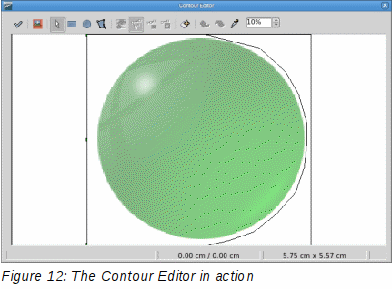
Figure 13 shows an example of page wrapping in action.
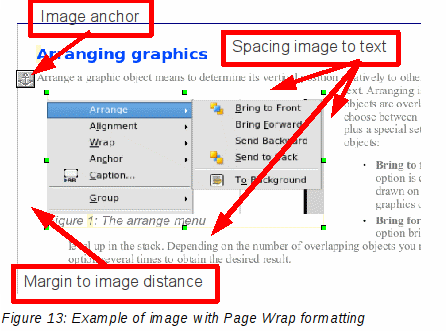
The process to obtain this is the following:
Insert the image into the document, then anchor it to the first paragraph. To move the anchor, select the image and move it until the anchor symbol is at the beginning of the paragraph. Do not worry about the position as that will be fixed in the next step.
Align the image so that the left margin of the image is in line with the paragraph indentation. This can be done with the mouse or using the advanced settings. In the example, the image is placed 1 cm from the left margin.
Change the wrap to Page Wrap. It starts out OK; however, there is still too little space between the image and the text. To correct it, access the Wrap page of the Picture dialog box and set the gap between the image and text to 0.2 cm in the Right and Bottom boxes.
The last touch is to change the position so that the image is below the first line of the paragraph. Again, you can use the mouse to drag the image or use the advanced settings, which require a bit of trial and error. The line height used in this guide—0.75 cm from the top margin of the paragraph—is a good value.
Example 2: simple contour wrapping in action
In this example we again apply page wrapping as in example 1, enabling this time the contour option. We will work on an image and on a drawing object as the contour option works slightly differently in the two cases.
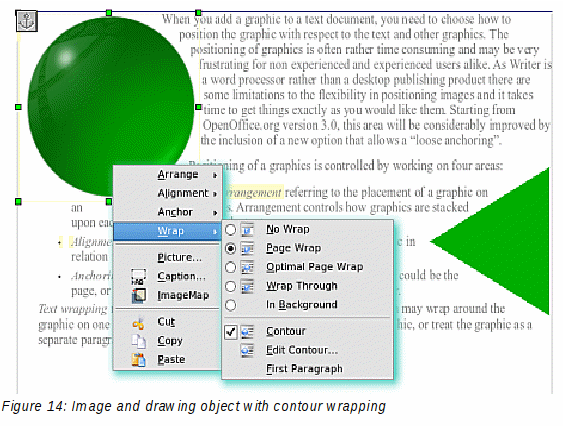
The example of Figure 14 has been built following the steps below, which you can use to practice.
Create some text (a very quick way to do that is to use the dummy text AutoText. That is, type DT and then press the F3 key).
Insert an image of your choice and anchor it to the first paragraph. Adjust the alignment as desired then change the wrap type to Page Wrap.
Right-click on the picture to select the option Wrap → Contour, then right-click again and select Wrap → Edit Contour from the context menu.
Use the technique discussed in “Editing the contour” on page 22 to create a custom contour and click Apply. If needed, adjust the spacing between the edge of the image and the text.
Insert an AutoShape of your choice (a rotated triangle in the example) and proceed as in step 2 above.
Enable the contour wrap by selecting Format → Wrap → Contour from the menu bar. As discussed previously, LibreOffice automatically generates the contour. You may need to adjust the distance between the drawing object and the text.
Example 3: Wrap Through and In Background
This example shows how to use an image as a watermark by wrapping it through the text and adjusting the transparency. This is not the best way to create watermarks and it is presented here only for its illustration purposes. If you need to create a watermark, it is best to use a Fontworks object wrapped in the background.
The Wrap Through option inserts an image overlapping the text which as a result will be hidden. To make the text appear, change the transparency of the picture; although the words under the image become visible, they may be difficult to read and will appear lighter than the rest of the text.
To reproduce the example of Figure 15 create some dummy text, then insert the image of your choice. Anchor the image (to the page in the example) and select the wrap through option from the Format → Wrap menu or right-clicking on the image and selecting Wrap → Wrap Through from the context menu. Move the image into the desired position. The Picture toolbar should be displayed when the image is selected. Change the transparency to a suitable value (in the example this is 40%) so that the text can be read.
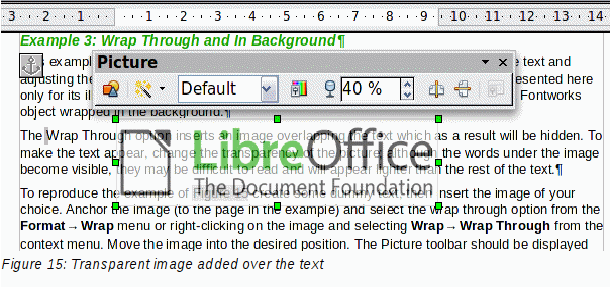
You can obtain a better result if you set a graphic’s wrap to In Background. In this case all the text will be clearly readable, with characters that have the same intensity as long as the background is not too dark. Also in this case you may want to adjust the transparency of the image.
You can add captions to graphics in three ways: automatically, by using the Caption dialog box, or manually.
You can set up LibreOffice to add captions automatically whenever you insert a graphic, a table, or other objects into a document. You can choose which objects are captioned automatically, what the sequence name is for each caption (for example, “Table” or “Illustration”), and the position of the caption.
To set up automatic captions:
Click Tools → Options. On the Options dialog box, click on the + sign next to LibreOffice Writer to show a list of options.
Select AutoCaption. Now you can see several choices at the right of the dialog box for adding captions automatically.
Choose which objects you want to be automatically captioned and specify the characteristics of the captions.
For more information, see “AutoCaption options” in Chapter 2, Setting up Writer.
When you insert a graphic, if automatic captioning is enabled, the graphic is placed in a frame along with a caption containing the default sequence name for graphics―Illustration. Position the cursor in the caption area and type the text for the caption. You can change the sequence name by selecting one from the drop-down Category list.
|
Note |
You can specify where to place an automatic caption for any object except a picture; picture captions can only be automatically placed below the picture. If you need a caption above the picture (for example, for data plots in scientific publications), you must add the captions manually, as described in “Adding captions manually” on page 27. |
|
Tip |
A common sequence name—Figure—is not one of the names provided: <None>, Drawing, Illustration, Table, and Text. If you want the name “Figure” or any other custom name for your graphics, do the following:
|
To add captions using the Caption dialog box:
Insert the graphic, then select it and click Insert → Caption.
Under Properties on the Caption dialog box (Figure 20), make your selections for the Category, Numbering, and Separator fields (Illustration, Arabic (1 2 3), and a colon (:), respectively, for the example in Figure 16 and type your caption text in the Caption text box at the top. Whatever text you enter for the caption appears in the box at the bottom, after the sequence name, number, and separator.
Click OK. The graphic and its caption are placed in a frame, as shown in Figure 17.
|
Tip |
In the Category box, you can type any name you want, for example Figure. LibreOffice will create a numbering sequence using that name. |
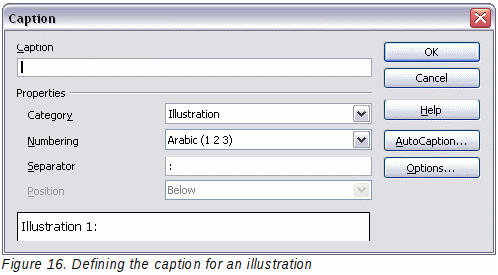
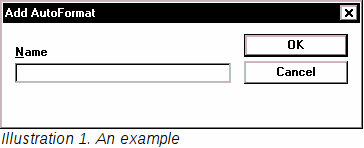
Figure 17. An example of a graphic and its caption contained in a frame. The outer box shows the edge of the frame; this border is normally set to be invisible.
Overriding the default positioning of captions
The default positioning for picture captions is Below, and that position cannot be changed using the Caption dialog box. However, you can override the positioning manually, as follows:
Follow the instructions in “Using the Caption dialog box” on page 26 to create the caption.
Right-click on the picture (not the frame surrounding picture and caption) and make sure that Anchor → To paragraph is selected.
Left-click on the picture and drag it below the caption.
|
Tip |
You may wish to adjust the spacing above and below the caption text, to fine-tune the appearance of the picture and its caption. |
If you need to save as *.doc files or export in other formats, you may find that captions applied as described above (either automatically or using the Caption dialog box) are lost during the export. To avoid export problems, or as another way to put captions above pictures or below them (the usual case), you can add a caption manually, in either of two ways:
Place the graphic and its caption in separate paragraphs.
Use a table.
Place the graphic and its caption in separate paragraphs
Insert the graphic and anchor it to its paragraph as a character. Press Enter to create a new paragraph for the caption.
In the caption paragraph, type, for example, Figure and add a space.
To insert the figure number automatically, click Insert → Fields → Other (Control + F2) and select the Variables tab.
Select Number range in the Type list. Select Figure in the Selection list and choose, for example, Arabic (1 2 3) in the Format drop-down list. Click the Insert button.
A number will appear after the word “Figure” in the caption. Now, type the text of the caption.
|
Tips |
If you are manually adding captions to a lot of figures using this method, you might want to make an AutoText entry containing, for example, Figure and a space, the figure-number field, and an optional separator and a space after it. To ensure the picture and its caption stay together on the page: if the picture is going above the caption, define the text flow of the Figure paragraph style as Keep with next paragraph and the next style as Caption. Conversely, if the caption is going above, define the Caption paragraph style as Keep with next paragraph and the next style as Figure. |
Create a one-column, two-row table. Place the picture in one row and type the caption in the other row—or use two or more rows for the caption and other text. This method can be especially useful for pictures with numbered legends, such as Figure 9 in this chapter.
An image map defines areas of an image (called hotspots) with hyperlinks to web addresses, other files on the computer, or parts of the same document. Hotspots are the graphic equivalent of text hyperlinks (described in Chapter 12). Clicking on a hotspot causes LibreOffice to open the linked page in the appropriate program (for example, the default browser for an HTML page; LibreOffice Calc for a .ODS file; a PDF viewer for a PDF file). You can create hotspots of various shapes and include several hotspots in the same image.
To use the image map editor:
In your LibreOffice document, select the picture where you want to define the hotspots.
Choose Edit → ImageMap from the menu bar. The ImageMap Editor (Figure 18) opens.
Use the tools and fields in the dialog box (described on the next page) to define the hotspots and links necessary.
Click the Apply
icon
![]() to apply the settings.
to apply the settings.
When
done, click the Save
icon
![]() to save the imagemap to a file, then click the X
in the upper right corner to close the dialog box.
to save the imagemap to a file, then click the X
in the upper right corner to close the dialog box.
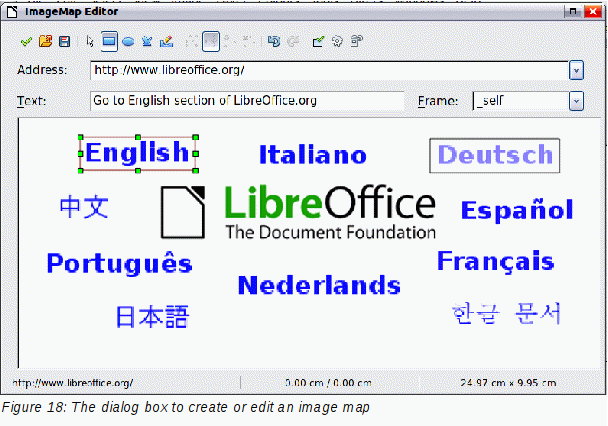
The main part of the dialog box shows the image on which the hotspots are defined. A hotspot is identified by a line indicating its shape.
The toolbar at the top of the dialog box contains the following tools:
Apply button: click this button to apply the changes.
Open, Save, and Select icons.
Tools for drawing a hotspot shape: these tools work in exactly the same way as the corresponding tools in the Drawing toolbar.
Edit, Move, Insert, Delete Points: advanced editing tools to manipulate the shape of a polygon hotspot. Select the Edit Points tool to activate the other tools.
Active icon: toggles the status of a selected hotspot between active and inactive.
Macro: associates a macro with the hotspot instead of just associating an hyperlink.
Properties: sets the hyperlink properties and adds the Name attribute to the hyperlink.
Below the toolbar, specify for the selected hotspot:
Address: the address pointed by the hyperlink. You can also point to an anchor in a document; to do this, write the address in this format: file:///<path>/document_name#anchor_name
Text: type the text that you want to be displayed when the mouse pointer is moved over the hotspot.
Frame: where the target of the hyperlink will open: pick among _blank (opens in a new browser window), _self (opens in the active browser window), _top or _parent.
|
Tip |
The value _self for the target frame will work just fine in the vast majority of occasions. It is therefore not recommended to use the other choices unless absolutely necessary. |
Adding an image to the Gallery
You may wish to add to the Gallery any images that you use frequently, for example, a company logo. You can then very easily insert these graphics into a document later.
To add images to the Gallery, proceed as follows:
Open the Gallery.
Select the theme where you want to add images, or you can create a new theme. Note that you can add images only to “My Theme” or to any other theme that you have created; these are indicated by a green icon in the list of themes. You cannot add images to the built-in themes, indicated by an icon of another color.
To create a new theme:
Click the New Theme button above the list box of Themes. The Properties of New Theme dialog box opens, which is similar to the one shown in Figure 19.
Select the General tab (not shown) and type a name for the new theme in the text box.
Select the Files tab, skip step 3, and continue with step 4.
Right-click on the desired theme and select Properties in the context menu. This displays a window from which to select the files to be added.
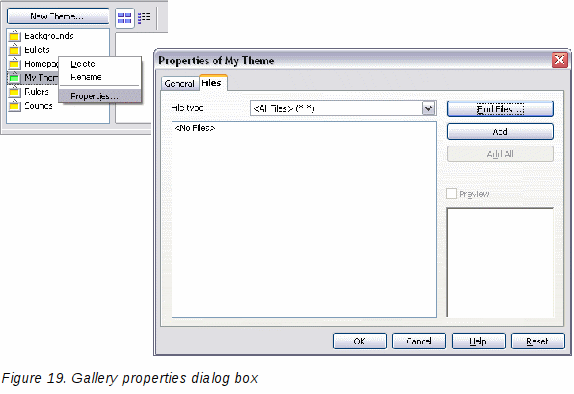
On the Files page, click the Find Files button. The Select path dialog box opens.
You can enter the path for the file’s directory in the Path text box, or you can navigate to locate the file’s directory. Use the File type drop-down list to help limit the search.
Click the Select button to start the search. A list of graphic files is then displayed in the window. You can use the File type filter again to further limit the search.
Select the files to add. To select more than one file, hold the Control key down while you click on each file.
Finally, click Add.
When
you have finished working with the Gallery, you can click on its
icon
![]() to close it.
to close it.
|
Note |
This procedure assumes that the graphic files for the themes already exist. You may need to import some graphics or create your own on your computer if the existing files are insufficient. |
|
Note |
Similar to the file search function on various operating systems, Find Files searches for graphic files in any subfolders of the directory selected in step 5. |